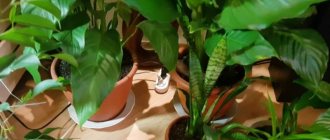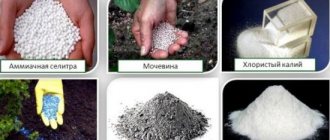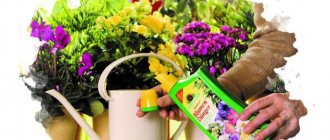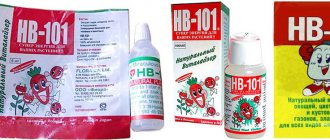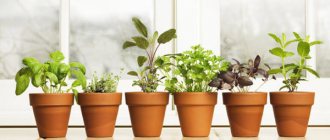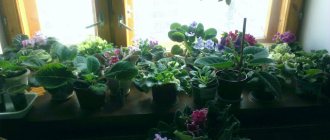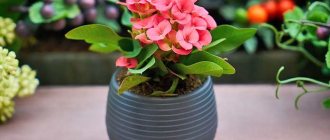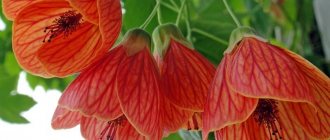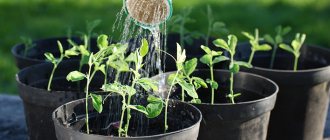Indoor plants – decorative foliage and flowering ones – delight gardeners all year round. A huge variety of types, shapes and colors allows you to decorate with them rooms for a wide variety of purposes. Undoubtedly, everyone has their own favorite flower, to which a caring owner pays the most attention. But what if the plant begins to lose its decorative appearance, stops blooming or grows poorly?
Most likely, the root of the problem lies in insufficient nutrition , because it is indoor crops that most often experience a lack of nutrients. The thing is that domestic plants growing in tubs, flowerpots, pots, containers and other utensils cannot extract nutrients from the soil, like their counterparts growing in open ground. The size of the container does not allow the roots to grow in search of nutrients, so when the soil in the pot is depleted, the plant begins to “starve”.
Indoor plants are an important decorative element for interior design in any style.
On the shelves of gardening and flower shops you can see a wide variety of special compositions for feeding indoor crops , but in any kitchen or even in a home medicine cabinet there are always suitable components that are no worse than store-bought products.
Natural fertilizers containing large amounts of vitamins and minerals are often simply thrown into the trash and housewives do not even suspect how some food waste can be used to benefit the home flower garden.
Natural flower food rich in mineral elements
Rules for using homemade fertilizers
Before using your own prepared fertilizers for indoor plants, you should study the rules for their use. An excess of nutritional compounds can be just as destructive as neglecting the feeding procedure.
Feeding of home flowers and plants is carried out during the period of their growth and flowering.
Manure
Fresh manure is rarely used. Its maturation lasts from 12 months to 2 years. The application rate in the fall when digging a site is 5–8 kg per square meter. m. In the spring, it will be necessary to feed the planting again due to the decrease in nitrogen content in the manure during its maturation.
The use of fresh manure is also possible in the form of an aqueous solution. It is used to water garden crops at the roots during their growth. To obtain liquid fertilizer, you need to fill the bucket ½ full with manure and add water to the top.
The solution is kept covered for 3 days. Before use, the resulting concentrate is diluted with water in a ratio of 1:20.
When to feed plants
A signal of a lack of nutrients can be slow growth, weak flowering or its complete absence, pale leaves, the appearance of light spots, thinning and elongation of stems. With sufficient lighting and temperature, a lack of vitamins and microelements can lead to such a poor condition.
It is recommended to start applying fertilizers at the beginning of March, when daylight hours increase and plants begin to wake up from winter hibernation. Many house flowers enter the active growth phase in the spring, so additional nutrition is more important than ever for them. From March to October, it is recommended to feed indoor crops twice a month. Fertilizing does not stop even with the beginning of flowering.
Fertilizer for house plants can be used in both dry and liquid form
In cold weather, from mid-autumn to the end of February, most indoor flowers are in a state of hibernation, so they do not need additional feeding. But if the plants do not stop growing or bloom in winter, then they should also be fed with fertilizers, but 2 times less often.
Chicken droppings
Poultry droppings are rich in nitrogen and phosphorus. It is applied to the soil before planting seedlings and used for watering plants at the root in the form of an aqueous solution.
To obtain liquid bait, pour chicken droppings with water in a ratio of 1:20 and leave for several days. This natural fertilizer will improve the growth of garden crops.
To rid the nutrient liquid of an unpleasant odor, experienced gardeners recommend enriching it with copper sulfate crystals.
How to use natural fertilizers
Fertilizing must be applied after moistening the earthen clod the next day. If you fertilize plants on dry soil, you can burn the roots and ruin the flower. Nutrient formulations can be diluted with water or used in dry form. Dry agents are sprinkled on the top layer of soil, then loosened and watered.
Advice! Liquid formulations are best poured closer to the edges of the pot. You should not overwater the plant; a small amount will be enough. Take settled, warm water.
Coffee grounds
It contains a large amount of nitrogen, which is released gradually and nourishes the soil for a long time. It also contains valuable minerals such as magnesium, potassium, phosphorus and copper.
Coffee attracts earthworms, which effectively aerate the soil. And, conversely, it repels unwanted ones, such as snails and ants. Coffee grounds can simply be poured around plants or added to compost as a source of nitrogen.
Recipes for preparing natural homemade food for indoor plants
There are many recipes for preparing fertilizers from improvised means; just choose the most suitable option and composition from what you can find in the kitchen or in the medicine cabinet.
Natural fertilizers increase the protective properties of indoor plants, making them more resistant to disease
Yeast fertilizers
- In terms of effectiveness, yeast can be equated to complete mineral preparations . They are rich in B vitamins, phytohormones, substances that stimulate growth and a host of other elements that indoor flowers will enjoy. Yeast bacteria have a positive effect on growth and budding, making the microflora of the earthen coma better.
Take 10 grams of natural yeast, sold in briquettes, 1000 ml of water and a spoonful of sugar. You can also take 1 gram of dry instant yeast and 1000 ml of water, add a small spoon of granulated sugar. The mixture is left for 2-3 hours, then diluted 1/5 with water.
Fertilizing with yeast improves the mechanical structure of the soil, while simultaneously enriching it with useful microelements
Beer feeding
An intoxicating drink will have a good effect on “green pets”, but you should choose live beer rather than pasteurized bottled beer. The drink will continue to ferment in the soil, enriching it with carbon dioxide. You will need 200 ml of beer per 1000 ml of water. Use once a week.
Beer supplement
Coffee
Nitrogen-rich coffee will also be an excellent nutrition for plants, especially in the spring, when they wake up from winter hibernation. Nitrogen stimulates vigorous growth of foliage and shoots, and also makes the soil softer and lighter, which helps the roots receive more oxygen.
Of course, not every coffee will do. You need to use only natural brewed coffee, just drink the drink itself, and dry the grounds and put them in a separate container. When a sufficient amount has accumulated, which is enough for all the plants, you can begin to add it to the soil. Take 2 tsp for one pot. coffee grounds, spread over the surface of the soil, loosen and water.
Coffee beans are very often used as fertilizer for indoor plants.
When using coffee as a home fertilizer, you need to know that it increases the acidity of the substrate, so this option may not be suitable for some crops. Can be used for poinsettias, azaleas, passionflowers, roses, rhododendrons, lilies and gladioli.
Tea
House flowers will also like tea leaves. After it, the soil becomes light, but small flies like this feeding. Like coffee, you will need 2 teaspoons per plant. Ferns really like tea, and if the drink is also sweet, then the plant will be especially grateful.
Tea brewing helps keep your favorite flowers healthy
Sweet top dressing
During the breakdown process, sugar is converted into glucose and fructose, and it is glucose that provides energy. After feeding with sugar, the plants will respond with vigorous growth, but it is better not to use this method too often; one application per month will be enough. If used too frequently and in heavy soils, sugar can cause mold and rot to grow.
Sweet sand is scattered over the surface of the contents of the pot before watering or diluted with one tablespoon in 500 ml of water. Regular pharmacy glucose will also work. It is diluted one tablet per 1000 ml of water. Glucose solution is also used once a month.
Green sweet tooth
Onion peel decoction
Take 50 grams of onion peel and pour 2000 ml of boiling water, cook for 5 minutes. The resulting broth is left to infuse for 2-3 hours and filtered. Water and spray indoor crops once a month. You cannot store the decoction; it is better to immediately pour out the remainder and prepare a new one for the next use.
You no longer need to spend money on buying fertilizers if you have onions in the house
Egg shells
Eggshells are often scattered over garden beds, but they are also well suited for home use. The calcium-rich shells remaining after raw or boiled eggs are dried and crushed into crumbs or dust.
You can simply scatter them on the ground and loosen them, or you can prepare an infusion for watering. Pieces of eggshells will also provide good drainage if you sprinkle them on the bottom of the pot when replanting your “green pets.”
Everything is useful on the farm, even eggshells
Banana skins
Bananas contain a lot of potassium, which has a positive effect on flowering and leaves, which from such fertilizing become juicy and take on a rich, bright color. Of course, you may not regret the pulp of a ripe fruit for your pets. Then mash the peeled banana well, add 200 ml of water, stir and feed the flowers with a spoon.
It is best to use tropical fruit peels as fertilizer, as the tasty pulp has other uses.
The peel is prepared as follows:
- Dry and wash into powder.
- Pour into a jar, pour 1/1 water.
- Close and leave for 24 hours.
- Strain and add water to the previous level.
The resulting infusion is used for watering once every 4 weeks.
As you can see, banana is useful not only for humans, but also for plants
Citrus fertilizers
The peels of any citrus fruits can also be dried, ground, poured into a bowl 1/3 full and filled with boiling water. After a day, filter the infusion, bring the volume of water to 1000 ml and use the resulting composition for watering once every 30 days.
You can prepare a citrus-banana duet by taking the ingredients in equal parts. Fill 1/3 of the jar with this mixture, pour in warm water and add two small spoons of sugar. The composition is kept in a warm place for about 3 weeks and shaken periodically. Before use, dilute 1/20 with water, and store the rest of the liquid in the refrigerator. Frequency of use: 1 time every 30 days.
Natural fertilizer made from citrus peels is suitable for most indoor flowers and plants
aloe leaves
Aloe leaves are ground in a meat grinder or blender, and the grounds are drained. The juice is diluted with water, taking 1 teaspoon per 1500 ml of water. This will help stimulate the growth of indoor plants.
Garlic fertilizers
Garlic water is an excellent remedy for preventing diseases, getting rid of spider mites and disinfecting the soil, as well as strengthening the immunity of indoor crops.
Take 4-5 cloves of garlic, grind them into a paste, then dilute with 1000 ml of warm or hot water. The garlic water is left to steep for 5 days in a warm, dark place. A spoonful of the prepared infusion is diluted with 1000 ml of water and used to water or irrigate the green part of the flower.
Fertilizing plants with garlic in spring will have a beneficial effect on their growth.
Orchids, violets, pelargoniums, dracaenas and other indoor crops are favorably treated with garlic water. The only caveat: during flowering, it is not recommended to use . Apply once every 14 days.
Castor oil
During the period of bud setting, plants will be happy with this nutrition. Take 1 small spoon of oil per 1000 ml of water.
Vitamin supplements
Vitamin B12 is important for growth and violets will really like it. Take 1 ampoule per 1000 ml of water and water the flowers with this solution. Aspirin is perfect for spraying. The crushed tablet is dissolved in 1000 ml of water.
If indoor plants grow poorly, have weak stems and their color has become pale, this is a signal that they lack certain vitamins, including vitamin B12
Fertilizing with ammonia
Ammonia can be a wonderful nitrogenous fertilizer for home flowers . This product is well absorbed and flowers really like it, especially during the period when the active growth of green mass begins. It helps restore strength and cheer up after winter.
Take a large spoon of ammonia per 1000 ml of water and water the flowers. After just 3 days, even a depleted plant will begin to turn green and soon bloom. A solution of ammonia not only invigorates the plant, but also disinfects the soil and helps fight fungus.
Iodine
This element helps plants regain their strength, stimulate shoot growth and flowering. Most often, this recipe is used to feed geraniums. It is important to calculate the dosage. For 1000 ml of water, only 1 drop of an alcohol solution of iodine is needed, and only 50 ml of the finished composition can be used for each plant. Water the flower carefully, away from the stem and closer to the edges of the flowerpot.
Iodine supplement is beneficial for most indoor plants
Hydrogen peroxide
- Fertilizing with hydrogen peroxide helps solve many problems . It heals foliage and soil, and is also used for preventive treatment against diseases and parasites. Peroxide will quickly restore fading indoor flowers.
To prepare a useful solution, take one large spoon of hydrogen peroxide per 1000 ml of water. Water or spray the flowers once a week.
Coal and ash
Coal and ash are often mixed into the soil mixture when replanting. They are rich in minerals, which makes them one of the best supplements. In addition, coal mixed with soil disinfects the substrate and protects plant roots from rotting. You can also prepare liquid fertilizer by taking 1 spoon of ash per 1000 ml of water.
Coal and ash will appeal to flowering flora
Aquarium water is also considered a natural fertilizer for home flowers Use it only in spring and no more than once every 4 weeks. Otherwise, the “green pets” can only be harmed, not helped.
succinic acid
Particularly favorable to succinic acid are chlorophytum, aglaonema, citruses, ficus, begonia, prickly pear, haworthia and crassula. You can use succinic acid no more than once per year. Take 1 g of the drug per 5 liters of water.
Organic fertilizer
- Organic fertilizers for indoor plants are a universal natural product that is suitable for both home flowers and plants in the garden. Only when selecting the composition of the fertilizer is it important to take into account the preferences of “green pets”, since not all of them respond well to such fertilizing.
Ficus, palm, citrus, dieffenbachia and monstera trees prefer bird droppings. It is more concentrated and is excellent for feeding fast-growing and large plants.
- Take 10 g of bird droppings and 3 liters of water, mix thoroughly until the liquid becomes greenish in color.
- First, the plants need to be watered and only then pour in the prepared preparation.
- Leaf humus is mixed into the substrate during flower transplantation. This helps make the soil loose, light, it begins to allow air to pass through better and is enriched with useful microelements.
Cow or pig manure is less nutritious, so humus on this basis is not often used. Before use, mix it with water, taking 100 g of product per 10 liters of water.
If you do not add organic fertilizers (humus) to the soil, plant growth may slow down.
When choosing this method, it is important to remember that animal droppings have an unpleasant odor that can last for several days. If humus is made using accelerated technology, there will be no smell, but such compounds can only be mixed into the soil.
Compost
Natural complementary food consisting of rotted organic waste. The following are placed in the compost heap in layers:
- manure and poultry droppings;
- annual weed;
- fallen leaves, tree bark, branches;
- vegetable and fruit peelings;
- eggshells;
- vegetable tops;
- straw;
- garden soil.
Perennial weeds, heat-treated vegetables and fruits, diseased vegetation, and synthetic materials are not used to produce compost.
Place the components in a pile, observing the proportions for each layer. This will ensure that the compost matures evenly. The ratio between sources of carbohydrates (straw, fallen leaves, tree bark) and nitrogen (grasses, tops, manure, chicken droppings) should be 1:1.
The compost heap is arranged on an area of 2–3 square meters. m. It is advisable to first dig a hole with a depth of 0.5 to 1 m.
It will take 1-2 years for organic fertilizer to mature. The use of industrial concentrates (Ogorodnik, Siyanie, Baikal EM-1, Vostok EM-1), fermented milk products or ordinary earthworms will help speed it up.
Less popular natural supplements
There are several other remedies that will help refresh depleted indoor flowers. They are not so popular, but gardeners note their high efficiency:
- Water in which meat and fish were washed . If you water your favorite plants with water in which you washed meat or fish, the flowers will soon come to life, becoming bright, lush and juicy.
- The water in which the cereals were washed . Water after buckwheat, rice, millet or other cereals rich in silicon, iron, phosphorus and magnesium is suitable.
- Toothpaste . Feeding with toothpaste will help nourish the root system, making the entire plant stronger. To do this, you need to dissolve 1/3 of the tube in 1000 ml of water. To prepare a composition based on tooth powder, you need to take 3 tbsp. spoons of the product and the same amount of wood ash, one spoon of copper sulfate and dilute all components in 1000 ml of water.
Succulents do not need to be fertilized too often, however, in the spring, like other indoor plants, they also need it
Buy or cook?
In order to correctly answer the question “it is better to buy or prepare organic fertilizer yourself,” you need to understand the situation a person is in.
If you live in the city and visit your summer cottage on weekends, then it is better to buy ready-made organic matter. This makes it easier and faster to wake you up in a time that you don’t have much of.
If you live in a private house and the greenhouse is nearby, it is foolish to throw away waste residues that can increase the fertility of your beds.
The nuances of using natural fertilizers for home flowers
Before you start using self-prepared natural fertilizers, it is important to observe the condition of the plants and follow several rules:
- After transplantation, you should not start fertilizing earlier than 2 months.
- Feed the flowers only after the substrate has been moistened.
- Depleted and diseased flowers are fed with caution, in a reduced dosage.
- House flowers are usually fed during the active growth phase in spring and summer.
- When using even natural fertilizers, it is important to choose the correct frequency and dosage of fertilizing, since an excess of nutrients is no less harmful to plants than their deficiency.
There are many benefits from homemade recipes for nutritional formulations. Therefore, if a gardener notices that a plant in comfortable conditions begins to fade, stops growing, or does not want to bloom, you can simply choose any of the above methods and try it on your pet.
Author of the article: Kunin Vladimir Filippovich
- Related Posts
- How to make the right compost with your own hands at home
- How to make an alpine slide at your dacha with your own hands (photo)
- Secrets of growing white cabbage seedlings
« Previous entry
Green manure
You can fertilize the area where you plan to grow vegetable crops by sowing it with green manure - annual plants that quickly gain green mass:
- peas, lupine, alfalfa, clover to enrich the soil with nitrogen;
- mustard, oilseed radish to saturate the soil with phosphorus and repel insect pests;
- rye, oats, wheat to increase the content of potassium, phosphorus, nitrogen in the soil and suppress the growth of weeds;
- buckwheat to improve the composition and structure of the earth, reducing its acidity;
- calendula, sunflower to enrich the soil with nitrogen;
- phacelia to attract honey insects.
Some green manures are sown in the spring, while others are sown before winter. In summer, you can grow mustard and phacelia, planting them next to vegetable plantings or between rows to control pests or to attract honey insects.
After they have collected green mass, green manure is mowed and left to rot on the site.
Microfertilizers.
Tsitovtit.
The drug contains a full complex of microelements in an organic form that is most accessible to plants. Increases the productivity of fruit, berry and vegetable crops, and the decorativeness of flower crops.
Soaking seeds and fertilizing with cytovit accelerates seed germination and plant growth, increases plant resistance to unfavorable growing conditions and overwintering. They reduce the fall of the ovary, prevent the death of growing points and the disease of fed crops with such diseases. Such as chlorosis, various leaf spots, “rosette” of fruit, rot.
The greatest effect is achieved by jointly treating seeds, seedlings and vegetative plants with epin-extra and cytovit, and for root crops with zircon and cytovit.
Gibberellins.
Stimulates seed germination, flowering and fruit formation. Increases productivity. They also remove tubers and bulbs from dormancy. Unlike Auxins, they do not redistribute nutrients but only accumulate them.
Gibberellin.
It affects the functioning of the chromosomal apparatus. Capable of significantly influencing the length of the stem. At the same time, it can stimulate both cell division and cell elongation. At the same time, gibberellin does not affect root growth, and in increased concentrations in a water culture it even worsens the condition of the roots.
Gibberellin also activates seed germination, fruit growth, and delays the reddening of tomatoes. It is known that dormant buds and seeds of a number of species are brought out of dormancy by the action of low temperatures.
The temperature factor in these cases can be replaced by treatment with gibberellin. Photosensitive seeds require light to germinate. It can also be replaced with gibberellin.
Gibberellin is used to increase the yield of sultana (seedless) grape varieties, characterized by relatively small berries. Spraying the grapevine with a solution of 30 mg per 10 sq.m. during flowering or 5-7 days after flowering, it helps to increase the size of the berries by 1.5-2.5 times and increase the yield by 50-100%.
In addition, the ripening of grapes is accelerated by several days. But, in fairness, it must be said that sultanas made from processed grapes are worse.
Gibberellin also has a positive effect on some seed grape varieties. The number of berries increases, the number of seeds and seedlessness increases, the cluster loosens, which reduces the susceptibility of berries to phytopathogens, and ripening accelerates.
In order to increase productivity, gibberellin is also used to treat strawberry plantations.
Varieties
All homemade growth stimulants can be divided into two large groups: herbal and non-herbal. These include:
Vegetable:
- potato
- aloe vera
- onion peel
- nettle
- willow
- mushrooms
Non-vegetable:
- yeast
- honey
- hydrogen peroxide
- succinic acid
Let's look at the most popular recipes for folk remedies and their purpose.
